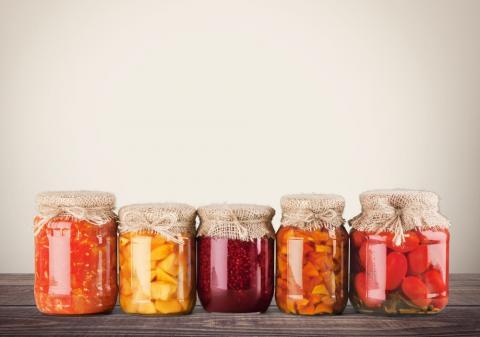
As the main canner and preserver in my family, I spend a few days in the autumn preserving as much of our harvest as I can. I usually end up with about 30 jars of pickled cucumbers, pickled beets, canned tomatoes, and pickled dill beans. Some of my friends have even given me jars of their home canned tart cherries, which is always exciting. I always find that the challenge, however, is later on in the winter. I encourage my family to enjoy the canned harvest but come spring I always seem to find a majority of my hard work has been left to collect dust on the shelf.
The problem is not an unwillingness to eat the canned foods but rather a lack of knowledge on how to best eat them. It’s true that it takes a little bit of know-how to properly enjoy a strong pickled beet or a tart preserved cherry. As we start to see small signs of spring, it’s a great time to open up your pantry and dig in to the harvest that is waiting for you. Here are some commonly preserved items and some ideas on how to use them!
Tomatoes
If you live in a particularly cold place like I do, a lot of your tomatoes might not end up having enough time to turn red on the vine. I’ve prepared everything from fried green tomatoes to green tomato salsa to try and enjoy the harvest even if it isn’t ripe. If you have a harvest of green tomatoes I encourage you to make and can some green tomato salsa, or my newest favorite discovery, green tomato chutney.
I use green tomato chutney on everything from tuna sandwiches to feta and chutney crostini at a dinner party. It makes a wonderful sweet and tangy spread that pops with flavor in whatever way you use it.
If I am able to preserve my red tomatoes, either by canning or freezing, I love to make a simple marinara or soup. Canned or frozen tomatoes are an important addition to most stews as well.
Green Beans
I could personally eat a jar of pickled beans (also known as dilly beans) straight because I love their tangy saltiness. Many, however, will find their strong vinegar flavor overwhelming. I like to use dilly beans much in the same way as pickled cucumbers. I slice them and lay them onto sandwiches or burgers, chop them up and add them to soups for a dash of extra saltiness, or add a few to a salad.
One of the sneakiest ways to use dilly beans is to chop them finely and use them as a replacement for capers. Capers are traditionally used in dishes such as chicken piccata, a delicious, light, lemony meal which can easily be made into a vegan alternative. Dilly bean capers can be used in potato salads and other creamy, rich meals for an added tanginess.
Beets
Pickled beets have been given a bad reputation as the one thing on the Thanksgiving dinner table that no one wants to eat. I used to steer clear of them myself until a friend turned me onto using them to spice up my usual salad at the dining hall during University. While raw beets preserve well over the winter, a couple of jars of canned and pickled beets will serve you well when it comes to spicing up your winter salads. I like to dice a couple of pickled beet slices and sprinkle them on my salads.
Fruits
Canned fruits are probably the easiest to use in jam and jelly form. A lesser made fruit preserve is fruit butter, which can be used much in the same way as your jams and jellies. I have friends, however, who are concerned about their sugar use and so refrain from making the high sugar jams and jellies, instead opting for just simple canning of their fruits.
One of the most popular canned fruits is actually pumpkin, which most Americans use in pumpkin pie for the holiday season. Use canned pumpkin in your next wintery pumpkin soup as well! You can also use canned cherries and peaches in a pie, perhaps trying out a vegan pie crust for fun.
Cucumbers
Perhaps the most common preserved item on the list, there are hundreds of different types of pickled cucumbers, usually referred to simply as “pickles,” for hundreds of different uses. There are sweet bread and butter sliced pickles for sandwiches and burgers. There are hearty, sour dill pickles to accompany a traditional deli sandwich, relish for your vegan hot dogs, and gherkins to accent a hearty winter meal.
One of my favorite uses for any type of pickle, however, is as an accent to a cheese board that I might lay out for a mid-winter dinner party. Any type of pickled food is an excellent contrast to rich and creamy foods. Whereas creamy foods can be rich and bland, pickled foods are sharp and tangy. When brought together in the right ratios, a combination of the two makes for a wonderful culinary experience.
On a cheese board, I like to include two to three types of cheese, ranging from mild to strong, some candied nuts, lightly dressed salad, honey or jam, and a small pile of pickles.
There are so many exciting ways to use canned foods and it’s a shame to let your hard grown and preserved harvest go to waste. I hope this article has given you some new ideas or inspired you to learn more about the ways to use canned foods. This list does not even include the wonders of fermented foods such as sauerkraut and kimchi, which also add excitement to a mid-winter meal. I encourage you to get creative and, most importantly, enjoy!








